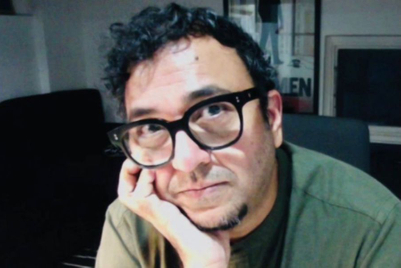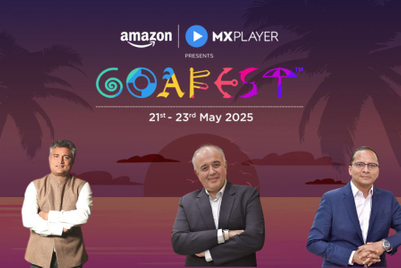
In an era where consumers are bombarded with over 6,000 ads daily, Youri Guerassimov, CEO and CCO of Marcel, Paris, emphasised that “visibility alone is not enough”, what cuts through the noise is courage in creative advertising. Guerassimov said this while delivering a keynote address on the third and final day of Goafest 2025. The session titled, ‘Creativity that dares to disrupt’ dealt with the essential role of bravery in modern advertising.
“Bravery in advertising,” he said, “is about stepping outside comfort zones and challenging norms.” He clarified that it’s not always about taking a political stance; it can be design-led, strategic, or rooted in purpose.
Guerassimov shed light on several examples from Nike’s bold Colin Kaepernick campaign to Volvo sharing its life-saving tech with competitors. He explained that courageous choices redefined brand identity and public perception.
He cited data underscoring this shift: 86% of consumers expect brands to speak up on social or environmental issues, while 66% are ready to switch brands when they do not align with their core values.
“Playing it safe doesn’t guarantee success; it guarantees invisibility,” Guerassimov warned. The session also celebrated smaller but impactful actions, like McDonald’s minimal billboard campaign or Marcel’s own ‘Inglorious Fruits and Vegetables’, which turned a humble retail idea into a nationwide movement.
“Even small changes, like a few words in a contract, can be acts of brand bravery,” he noted. Guerassimov urged brands to act not from fear, but from belief. “Fear is temporary; regret is forever,” he said.
Whether it is Patagonia’s profit donation or building store displays by hand, the message was clear: bravery isn’t about budget—it is about intent, conviction, and love for an idea. When wielded well, bravery becomes a strategic superpower that embeds brands in culture and hearts.
Behind closed doors: Inside the jury’s mindset
Another key development on Friday was a total of four sessions offered an unprecedented peek into the minds of this year’s Abby Awards jury, revealing a layered, sometimes intense, decision-making process rooted in relevance, storytelling, and bold creative choices.
Anupama Ramaswamy, chief creative officer and joint managing director, Havas Creative India emphasised that the jury gravitated toward campaigns that told untold stories with a purpose. Still, 'purpose' wasn’t enough on its own. “Big idea over cause,” she stated, pointing to winners like Lays x UNA’s Farm Equal, Reliance’s Pink Star Rating, and Mahindra’s Nanhi Kali. “These campaigns didn’t just raise awareness, they sparked real-world change through creativity,” Ramaswamy averred.
Vaseline’s skincare for the trans community and Navneet’s Colour Blindness Book exemplified innovation that served overlooked audiences, driven by sharp insights and empathy.
Raj Kamble, founder and CCO, Famous Innovations, provided a behind-the-curtain look at the mechanics. With 500 entries and just three days, jurors became audience members, hooked in seconds or lost forever. “The case study is an ad for your ad,” Kamble said, urging participants to ditch formulaic formats and instead tell a story that shows transformation. A compelling idea still needs well-crafted storytelling to survive the scrutiny of seasoned judges.
Senthil Kumar, chief creative officer, VML India, added a cinematic lens. For him and many jurors, effectiveness came down to memorability and repeat value. “Would you watch that film again?” was a guiding question.
“Ads like Lahori Jeera (brand visibility in every frame) and Veeba Desi Chinese (cultural play, catchy soundtrack) earned praise for originality in execution, even when concepts weren’t entirely new,” Kumar revealed.
Guerassimov stressed that “creativity is everything” when it comes to award-winning work. He also served on the jury this year, highlighting the importance of using at least three media channels strategically, not superficially.
Guerassimov noted that while the overall creative standard was high, the category remained intensely competitive. There were no clear trends; instead, originality and smart media usage set standout entries apart. He also stressed the importance of written explanations in submissions, helpful when videos lack clarity or detail.
The takeaway? Whether purpose-driven or punchline-heavy, work that lingered, through insight, emotional depth, or unexpected humour, stood out. The jury aimed not just to reward creativity, but celebrate ideas that moved people, broke formats, and dared to reimagine how brands show up in culture.
Developing compelling narratives in visual storytelling
Vivek Anchalia, founder and CEO of Amazing Indian Stories, showcased how AI is transforming visual storytelling in film and advertising. He highlighted that AI-generated visuals now surpass traditional animatics in clarity and flexibility, enabling creators to craft production decks that instantly convey mood, character, lighting, and location.
He explained that tools like Integrated Production Modules (IPM) have slashed pre-production time, and AI-generated drone shots, used in his upcoming film Naisha, eliminated costly location shoots.
The session also included a fireside chat with Lulu Raghavan that delved into industry implications. Anchalia noted: “While AI dramatically cuts costs, it doesn't eliminate them. Skilled AI artists still command premium rates.”
Anchalia also argued: “Agencies remain essential for strategic insight and cultural nuance. AI excels in generating visuals and sound effects but still lags in emotional storytelling and music composition.” He stressed that AI won’t replace filmmakers but empowers them to create at scale.
Navigating brand building in the age of attention
A session titled ‘Beyond the 20 Second Ad Window’, industry leaders from Airtel, Zenith, and GroupM unpacked the evolving dynamics of brand storytelling in today’s fragmented, hyper-personalised media environment.
Kanika Anand, GM – media, Airtel, emphasised that relevance is the new reach. She explained that the key to resonance lies in delivering platform-specific, creatively sharp content, whether short or long form, when audiences are scattered across platforms. “Short-form captures attention, but long-form builds connection,” she noted, citing Airtel’s internal tests.
Rashmi Sehgal, chief digital and transformation officer, Zenith, argued that context and content are inseparable. “It is not just about what the ad says, but where—and how—it appears,” she added. She advocated for a thoughtful mix of formats, tailored to a brand’s lifecycle, and stressed the importance of measurement in scaling campaigns effectively.
Ajay Mehta, head – content and creative services, GroupM, took a strategic lens, reminding the audience that content can span from “a minute to a movie.” The right format, he stressed, depends on the brand’s objective and audience behaviour. “Creativity wins when content feels native and hooks early,” he said, highlighting how reduced geographic barriers are opening new markets for bold, culturally resonant storytelling.

Building a transparent and trusted media ecosystem
In a session focused on restoring trust and efficiency in digital advertising, Tejas Apte, head of media and digital marketing at Hindustan Unilever Limited (HUL), made a strong case for accountability and reform. Apte highlighted the staggering reality that up to 30% of digital impressions may be fake or non-human, leading to significant waste and eroded trust. “Issues like ad fraud, bot traffic, and misuse of consumer data continue to threaten ROI and brand credibility in an ecosystem largely driven by ad-funded models,” Apte said.
Apte introduced the Indian Society of Advertisers’ (ISA) four-pillar media charter as a response to these challenges, focusing on safe ad placements, stricter viewability standards, cross-platform fraud prevention, and ethical use of first-party data. The charter, co-created with agencies and tech giants like Google and Meta, is a rare example of industry-wide collaboration.
Side notes
Goafest’s third day offered a vibrant mix of creativity, wellness, nostalgia, and purpose. Actors Jaideep Ahlawat and Vijay Varma captivated audiences with a candid conversation on storytelling and the evolving entertainment landscape. Luke Coutinho, an expert on holistic nutrition, and integrative and lifestyle medicine, addressed burnout in creative professions, sharing practical tools for mental resilience and sustainable productivity. Moreover, Rajeev Jain of DS Group unpacked the iconic Pulse candy’s marketing journey toward mass-market success.
The day also spotlighted sustainability with Karuna Singh and Debapriya Dutt from Earthday.org. Singh underscored the growing economic risks of climate change and the power of collective action under this year’s Earth Day theme, ‘Our Power, Our Planet’.


.jpg&h=334&w=500&q=100&v=20250320&c=1)
.jpg&h=334&w=500&q=100&v=20250320&c=1)
.jpg&h=334&w=500&q=100&v=20250320&c=1)
.jpg&h=334&w=500&q=100&v=20250320&c=1)
.jpg&h=334&w=500&q=100&v=20250320&c=1)

.jpg&h=334&w=500&q=100&v=20250320&c=1)
.jpg&h=334&w=500&q=100&v=20250320&c=1)
.jpg&h=334&w=500&q=100&v=20250320&c=1)





.jpg&h=268&w=401&q=100&v=20250320&c=1)
.jpg&h=268&w=401&q=100&v=20250320&c=1)

.jpg&h=268&w=401&q=100&v=20250320&c=1)
